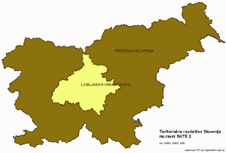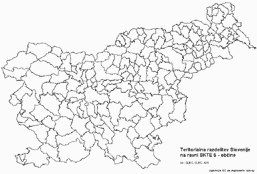With a population of only two million, small minority groups and one of the smallest territories of any European state, the formulation of a regional policy for Slovenia has never seemed urgent.
Slovenia's regional policy, such as it is, has been entrusted to several agencies: the Agency of the Republic of Slovenia for Regional Development, the Public Fund for the Development and Maintenance of Settlement of the Slovene Lands, and nine regional development agencies. Three more are planned, so that all twelve of the statistical regions will have their own.
 In the ten years since independence, a number of plans for a formal regional structure have been forwarded, and the country has faced criticism by international organizations, such as the European Commission for its lack of a third tier of government. Back in 1993, an expert mission was sent by the Council of Europe to analyze the situation, which inspired the first initiatives towards reform.
In the ten years since independence, a number of plans for a formal regional structure have been forwarded, and the country has faced criticism by international organizations, such as the European Commission for its lack of a third tier of government. Back in 1993, an expert mission was sent by the Council of Europe to analyze the situation, which inspired the first initiatives towards reform.
Things started getting interesting once the government realized it was missing out on European Union funds earmarked for regional development. As a country with no defined regions, it was ineligible for such monies. So in March 2000, the government formulated a bipartite regional plan which envisions two regions: an urban Ljubljana region, and the rest of the country.
The city of Ljubljana has reacted favorably to the plan, which gives it a privileged position. However, there have been outcries from the provinces which feel that the plan is not beneficial to them, and to their detriment.
The current scheme
Upon independence, the country created a two-tier governmental structure composed of the central government and 62 towns (občine) and municipalities (mestne občine). Today, there are 192.
There are two basic reasons why there has been little activity in the field of regionalization in Slovenia. On the one hand, no party has a direct interest in regionalization. On the other hand, towns enjoy the autonomy they have been given. In lieu of a regional structure, the government devolved a large degree of autonomy to the občine and mestne občine.
Other options
In recent months, the government's bipartite plan has come under fire from občine around the country. The most vocal opponents have come from the northern Koroška (Carinthia) area and Maribor mayor Boris Sovič.
Article 143 of the Constitution gives the občine the right to create regions on a voluntary basis, but no attempt was made to do this until 1998.
On that basis, three members of parliament from Koroška submitted a draft law to parliament on the creation of a formal Koroška region in February 1999. The bill's first reading in parliament caused a major controversy, while the second reading, in March 2000, inspired others to launch their own regional plans.
In June 2000 MPs from the towns of Brežice, Krško and Sevnica introduced a draft law on the creation of a Dolenjska region; In August, an MP from Črnomelj introduced a similar draft law on the creation of a Bela Krajina region; in September, an MP from Nova Gorica introduced a draft law on the creation of a Northern Primorska (Coastal) region composed of 12 towns from Ajdovščina and Nova Gorica to Sežana; and in October 2000 an MP from Desternik introduced a draft law on the creation of a Lower Podravje region, to be made up of the territory of the former municipal region of Ptuj.
Now that the government is pushing its bipartite plan, Koroška has renewed its call for formal regional status. In October, the mayors of 12 towns in the area sharply criticized the bipartite plan and expressed their support for a formal Koroška region.
The mayors would also like to see improvements in the government's programs for local self-administration and regionalism, and ultimately the creation of a Ministry of the Regions. They believe that the analysis of employment, economic, infrastructure and education statistics show great disparities among Slovenia's regions and this would best be addressed by a new ministry.
At the same time as the Koroška group was protesting the bipartite plan, Maribor mayor Boris Sovič also spoke out. A vocal critic of the government, and what he views as its centralizing policies, Sovič is stressing that his city and the historic Štajerska (Styria) region in general have significantly different needs and concerns than other areas.

Štajerska has the lowest levels of development and the highest levels of unemployment in the country, and has little in common with other parts of Slovenia which the bipartite plan includes in a single region. A better plan according to Sovič would be to recognize these facts and create a tripartite scheme composed of an urban Ljubljana region, an urban Maribor-Štajerska region and then the rest of the country.
These are not the only options. Other schemes which have been forwarded see Slovenia split up into anywhere from four to 58 units. One of the more potentially feasible schemes is to divide Slovenia into four regions, based on historical territories. This would see the country divided into the Kranjska (Carniola), Upper and Lower Štajerska (Styria) and Primorska regions.
Another scheme envisions 12 regions—Notranjska, Zasavska, Pomurska, Podravska, Koroška, Celjska, Dolenjska, Ljubljanaska, Savinska, Gorenjska, and Northern and Southern Primorska. These would be based on the administrative units created in the 1970s and are still used today for administrative purposes.
Pushing ahead
For now, the government is ignoring the calls for the reformulation of its bipartite plan and is going ahead with the scheme.
On 12 January, the head of the government's Division for Local Administration Vojko Grunfeld presented plans to establish a Regional Development Agency for the proposed Ljubljana Urban Region (RDA-LjUR). The Agency will be entrusted with development projects with the goal of equalizing the level of development throughout the region.
Twenty four občine and mestne občine will fall under the umbrella of the RDA-LjUR, but in order to reduce the time and trouble of establishing the Agency, it was decided that the city of Ljubljana would found it itself. On 15 January, the Ljubljana City Council approved the Agency's establishment and it should begin operation soon.
So far, 21 of the 24 localities have signed agreements of cooperation in the regional scheme.
The next major stumbling point in the creation of the LjUR is the fact that Parliament must still pass the Law on the Capital to formalize Ljubljana's status. The law has been made a priority for the current session.
The next steps
A delegation from the Council of Europe visited in December 2000, and the daily Dnevnik expected that the group would have to report that Slovenia's regional structure is stuck. The government continues to try to push through its bipartite plan, though with significant resistance from around the country. Each part of the country has its own ideas about what the regional structure should be, and only thing everyone seems to agree on is that Slovenia needs a regional structure.

|
Aside from coming to an agreement on the number and composition of the regions, much more work must be done before Slovenia will have a working regional structure. Further legislation is required, and a national development plan must be finalized. Also, once the regions are established, regional development agencies like the RDA-LjUR must be created.
The matter was a hot topic at a three-day conference this week in Bled, organized by the Agency for Regional Development (ARR) and the Public Foundation for Regional Development and Maintenance of the Settlement of the Slovene Lands.
The meeting assembled more than 300 representatives of towns, regions, ministries, businesses and NGOs as well as academics to discuss the state and prospects of regional policy in Slovenia.
The State Secretary of the Ministry of Economic Activities, Igor Strmšnik, told the conference that a more subdivided scheme would be composed of twelve statistic regions and 58 administrative units between the municipal and national levels.
The situation promises to get even more controversial in the near future. The EC has requested that the government submit a more detailed structure by the end of June.
Brian J Požun, 19 January 2001

Brian J Požun's new ebook now on sale from CER |
Elsewhere in CER:
Moving on:
- Archive of Brian J Požun's articles in CER
- Browse through the CER eBookstore for electronic books
- Buy English-language books on Central and Eastern Europe through CER
- Return to CER front page
Sources:
Delo
Mladina
Dnevnik
Večer
Ministry of Economic Relations and Development




